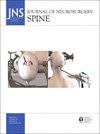Do obese patients undergoing surgery for grade 1 spondylolisthesis have worse outcomes at 5 years' follow-up? A QOD study.
IF 3.1
2区 医学
Q2 CLINICAL NEUROLOGY
引用次数: 0
Abstract
OBJECTIVE The long-term effects of increased body mass index (BMI) on surgical outcomes are unknown for patients who undergo surgery for low-grade lumbar spondylolisthesis. The goal of this study was to assess long-term outcomes in obese versus nonobese patients after surgery for grade 1 spondylolisthesis. METHODS Patients who underwent surgery for grade 1 spondylolisthesis at the Quality Outcomes Database's 12 highest enrolling sites (SpineCORe group) were identified. Long-term (5-year) outcomes were compared for patients with BMI ≥ 35 versus BMI < 35. RESULTS In total, 608 patients (57.6% female) were included. Follow-up was 81% (excluding patients who had died) at 5 years. The BMI ≥ 35 cohort (130 patients, 21.4%) was compared to the BMI < 35 cohort (478 patients, 78.6%). At baseline, patients with BMI ≥ 35 were more likely to be younger (58.5 ± 11.4 vs 63.2 ± 12.0 years old, p < 0.001), to present with both back and leg pain (53.8% vs 37.0%, p = 0.002), and to require ambulation assistance (20.8% vs 9.2%, p < 0.001). Furthermore, the cohort with BMI ≥ 35 had worse baseline patient-reported outcomes including visual analog scale (VAS) back (7.6 ± 2.3 vs 6.5 ± 2.8, p < 0.001) and leg (7.1 ± 2.6 vs 6.4 ± 2.9, p = 0.031) pain, disability measured by the Oswestry Disability Index (ODI) (53.7 ± 15.7 vs 44.8 ± 17.0, p < 0.001), and quality of life on EuroQol-5D (EQ-5D) questionnaire (0.47 ± 0.22 vs 0.56 ± 0.22, p < 0.001). Patients with BMI ≥ 35 were more likely to undergo fusion (85.4% vs 74.7%, p = 0.01). There were no significant differences in 30- and 90-day readmission rates (p > 0.05). Five years postoperatively, there were no differences in reoperation rates or the development of adjacent-segment disease for patients in either BMI < 35 or ≥ 35 cohorts who underwent fusion (p > 0.05). On multivariate analysis, BMI ≥ 35 was a significant risk factor for not achieving minimal clinically important differences (MCIDs) for VAS leg pain (OR 0.429, 95% CI 0.209-0.876, p = 0.020), but BMI ≥ 35 was not a predictor for achieving MCID for VAS back pain, ODI, or EQ-5D at 5 years postoperatively. CONCLUSIONS Both obese and nonobese patients benefit from surgery for grade 1 spondylolisthesis. At the 5-year time point, patients with BMI ≥ 35 have similarly low reoperation rates and achieve rates of satisfaction and MCID for back pain (but not leg pain), disability (ODI), and quality of life (EQ-5D) that are similar to those in patients with a BMI < 35.接受 1 级脊柱滑脱症手术的肥胖患者在 5 年随访中的预后会更差吗?一项 QOD 研究。
目的对于接受低位腰椎滑脱手术的患者而言,体重指数(BMI)的增加对手术效果的长期影响尚不清楚。本研究的目的是评估肥胖与非肥胖患者接受 1 级腰椎滑脱症手术后的长期疗效。方法确定了在质量结果数据库(Quality Outcomes Database)12 个入选率最高的研究机构(SpineCORe 组)接受 1 级腰椎滑脱症手术的患者。结果共纳入 608 名患者(57.6% 为女性),随访率为 81%(不包括 BMI ≥ 35 和 BMI < 35 的患者)。5 年随访率为 81%(不包括死亡患者)。BMI≥35组(130名患者,21.4%)与BMI<35组(478名患者,78.6%)进行了比较。基线时,BMI ≥ 35 的患者更年轻(58.5 ± 11.4 岁 vs 63.2 ± 12.0 岁,p < 0.001),同时伴有背痛和腿痛的比例更高(53.8% vs 37.0%,p = 0.002),并且需要行走辅助(20.8% vs 9.2%,p < 0.001)。此外,体重指数(BMI)≥ 35 的人群的基线患者报告结果更差,包括视觉模拟量表(VAS)显示的背部(7.6 ± 2.3 vs 6.5 ± 2.8,p < 0.001)和腿部(7.1 ± 2.6 vs 6.4 ± 2.9,p = 0.031)疼痛、Oswestry 残疾指数(ODI)(53.7 ± 15.7 vs 44.8 ± 17.0,p < 0.001)和 EuroQol-5D (EQ-5D)问卷调查的生活质量(0.47 ± 0.22 vs 0.56 ± 0.22,p < 0.001)。体重指数≥35的患者更有可能接受融合术(85.4% vs 74.7%,P = 0.01)。30天和90天再入院率没有明显差异(P > 0.05)。术后五年,BMI<35或≥35组接受融合术的患者在再次手术率或邻近节段疾病发生率方面没有差异(P > 0.05)。多变量分析显示,BMI ≥ 35 是 VAS 腿部疼痛未达到最小临床意义差异(MCID)的重要风险因素(OR 0.429,95% CI 0.209-0.876,P = 0.020),但 BMI ≥ 35 并不是术后 5 年 VAS 背痛、ODI 或 EQ-5D 达到 MCID 的预测因素。结论肥胖和非肥胖患者都能从 1 级脊椎滑脱症手术中获益。在 5 年的时间点上,BMI ≥ 35 的患者再次手术率同样较低,并且在背痛(但不包括腿痛)、残疾(ODI)和生活质量(EQ-5D)方面的满意度和 MCID 与 BMI < 35 的患者相似。
本文章由计算机程序翻译,如有差异,请以英文原文为准。
求助全文
约1分钟内获得全文
求助全文
来源期刊

Journal of neurosurgery. Spine
医学-临床神经学
CiteScore
5.10
自引率
10.70%
发文量
396
审稿时长
6 months
期刊介绍:
Primarily publish original works in neurosurgery but also include studies in clinical neurophysiology, organic neurology, ophthalmology, radiology, pathology, and molecular biology.
 求助内容:
求助内容: 应助结果提醒方式:
应助结果提醒方式:


